What: Here's the note on the back of the photo:
"This is a water pumping station on which a 1,000 ton rock fell on."
When: A trawl through the newspapers bring us to 18 & 19th July, 1926, and one of the greatest floods in Hong Kong's history. The newspaper reported [1]:
RECORD RAINFALL
17 INCHES IN SIX HOURS
The rainfall from 10 a.m. on Sunday ((the previous day)) to 10 a.m. today was 21.43 inches ((over 54cm!)) which is a record in some respects for the Colony.
Another column described the scene shown in the photo above:
FIVE LIVES LOST
DISASTER AT PUMPING STATION
Up to the present, the most serious occurrence that can be ascertained is the collapse of No. 3 pumping station, at Pokfulam Road, which is now buried under a huge fall of earth.
[...]
An enormous boulder, weighing anywhere between 500 and 1,000 tons, had been dislodged from the top of the hillside. At about nine o'clock this morning the whole district was shaken by a rumble, accompanied by a tremendous uproar, as the boulder slid down the hillside, and, gathering impetus, charged into the rear of the engine house of the pumping station. Trees standing in the way were simply obliterated. A storehouse where there was stocked a supply of waterpipes was crushed like a matchbox, two workmen who were working in it being killed outright. The enormous mass of rock then came to rest after crashing through the rear of the main engine house.
The following enquiry [2] upped the estimated size of the boulder to "several thousand tons".
Where: I believe this pumping station was on what's now part of the Hong Kong University campus. The University's decription of their new Centennial Campus says it is built on the "former WSD Elliot filters site" [3]. The 1924 map [4] clearly shows a pumping station at that site, just across the road from the Elliot battery.
Who: The only person visible in the photo is up in the top-left corner, giving an idea of just how massive this boulder was:
Trivia: The newspaper [1] noted this wasn't the greatest amount of rainfall recorded in 24-hours. That record was set in 1889, when 29.14 inches ((74cm)) fell between 6 a.m. May 29 to 6 a.m. on May 30. Does anyone know if that record still stands?
Regards, David
References:
- Hongkong Telegraph, page 1, July 19, 1926.
- The enquiry was reported over several days in the Hong Kong Daily press: 1926-09-04 pg 5, 1926-09-08 pg 5, and 1926-09-30 pg 4.
- Heritage Impact Assessment for Centennial Campus Project, The University of Hong Kong.
- 1924 Map of Hong Kong.
Reference: EA018
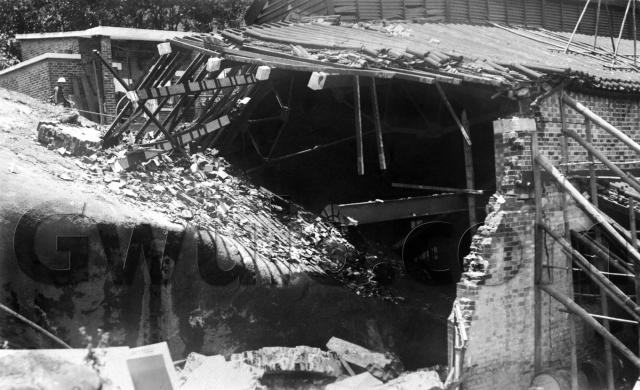

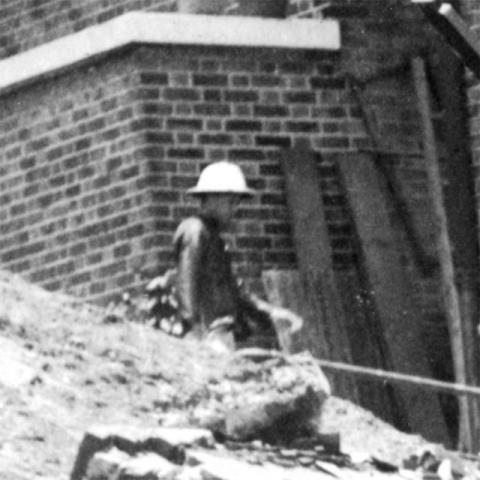

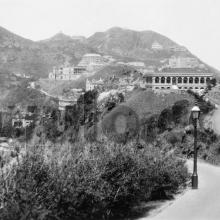
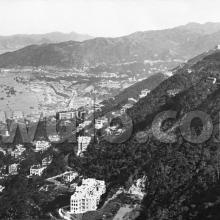
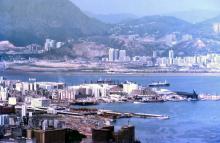
Comments
Scratching the surface of HK rainfall data
Hi David, interesting article you have here.
I am no expert on weather nor is climatology related to my work, but a casual web search identifies some interesting snippets:
1. The Hong Kong Observatory (HKO) website provides daily rainfall data from 2000 till the present, and there are some interesting numbers. (http://www.hko.gov.hk/cis/data/drf_summary_e.htm)
2. The HKO says that the record hourly rainfall currently stands at 145.5mm on 7th June 2008 (See http://www.hko.gov.hk/cis/statistic/erank06.htm). On the HKO link given in (1), however, we see that the storm wimped out soon after because they only recorded 307.1mm for the entire day. June 2008, however, claims the record for monthly rainfall with 1346.1mm (from the HKO page above), dethroning May 1889 which clocked in at 1241.1mm (see http://www.info.gov.hk/gia/general/200806/27/P200806270304.htm).
3. In terms of typhoon-induced rainfall, the July 1926 typhoon, which ostensibly caused the rockfall in this picture, was the second worst in the history of Hong Kong at 23.5 inches (587.5mm). See page 98 of this 2010 HKO document (http://www.weather.gov.hk/publica/tc/tc2010.pdf).
4. According to official HKO records, the record DAILY rainfall was not 740mm on 30th May 1889. In an old document that had data only up to 1970 (http://www.hko.gov.hk/publica/tn/tn038.pdf), we see that with non-cyclone related daily rainfall, 1889 does come in in first place, but only at 520.6mm (see Appendix 7b). The difference between this measurement and the newspaper's is likely in the different hours used for the 24-hour period. Using the HKO's method, the 1926 typhoon we are looking at here actually comes out on top at 534.1mm (Appendix 7a). Unfortunately, at the moment I am not able to find a more updated ranking. Some other day since 1970, typhoon or not, may well have surpassed both these measurements.
5. The closest I can come to a hall of fame for daily rainfall in Hong Kong is this page by the HKO: http://www.hko.gov.hk/cis/extreme/5day_extreme_e.htm. It measures 5-day periods of extreme climate events. From 26th-30th May, 1889 does take the gong at 908.9mm. In fact, comparing this number with other 5-day periods, 1889 is higher than any other by a margin of 230mm!. How about the period between 15th-19th July? 1926 does have the highest rainfall at 569.1mm, and comes in at 4th place on this table. But of course, some 5-day periods may have more than one extreme rainfall year, so 1926 may not be the 4th highest rainfall period in Hong Kong ever.
6. However, looking into the entrails of the HKO website, a technical note in 1994 (http://www.weather.gov.hk/publica/tn/tn086.pdf) gives a graph, figure 10b on page 46, that plots the observed maximum 24-hour rainfall against the time period in which it is likely to happen. Looking at the lines, that observed maximum is in the region of about 700mm, some way above the daily rainfall numbers we see above, and rather closer to the number you found (740mm) on the newspaper. That most likely is because the 24-hour periods do not correspond with rigid daily measurements, and it is probably that fateful day in 1889 itself. If that is the case, then 1889 stands as the record for 24-hour rainfall, but not daily rainfall.
So even though this storm in July 1926 is not the worst we have ever seen in Hong Kong, we are looking at a respectable typhoon and until we find better data in the archives (or get hold of a weather man who will do so for us), claims the title for daily rainfall according to official HKO methodology.
breskvar
Rainfall Records
Further to the very informative summary by Breskvar, I would like to provide the following additional information:
(1) 19 July 1926 still holds the highest daily total rainfall record at 534.1 mm. It ranks 6th in terms of the 1-hour total rainfall record at 100.7 mm.
(2) 30 May 1889 ranks 2nd in terms of the daily total rainfall record at 520.6 mm and it ranks 12th in terms of the 1-hour total rainfall record at 86.4 mm.
(3) 19-20 July 1926 ranks 2nd in terms of the 2-day total rainfall record at 561.2 mm and 29-30 May 1889 still holds the highest 2-day total rainfall record at 841.2 mm (and by a very large margin of 280 mm over the record of 19-20 July 1926).
CM Shun
Further Rainfall Records
If you are interested in the 24-hour rainfall records:
30 May 1889 (ending 06H) ranks first in terms of the 24-hour total rainfall record of 697.1 mm. The highest 24-hour total rainfall record for the 19 July 1926 episode was 552.2 mm.
CM Shun
Extreme rainfall
Thank you so much CM. May I ask where did you manage to find such information? Was that in house data at work or from some sort of library archive? Your number for 1889 of 697mm would match directly with what I saw on the HKO graph, and prove that the newspaper quoted number of 740mm to be erroneous.
To think that a once-in-a-century 24-hour rain occurred in 1889 gives me the shivers. Infrastructure would be so primitive then that the death toll and damage to buildings must be immense. And it wasn't even a typhoon. We would have heard of the damage on Gwulo if it was.
Now if someone can actually find the newspaper headlines of 31st May 1889 ...
breskvar
Re. Extreme rainfall
The information is from the records of the Hong Kong Observatory. I have asked HKO colleagues to enhance the climatological information webpages of the Observatory, e.g including ranking of the daily total rainfall records.
The death toll of the 1889 rainstorm episode was 27 (plus 17 missing), according to the book Weathering the Storm by Ho Pui-yin.
CM
Rainfall figures
Thanks Breskvar & CM, my question is well & truly answered!
Best regards, David
Pokfulam waterworks buildings
Facinating to see these buildings still preserved.
1926 Landslide photos
re: 1926 Landslide photos
Thanks for the extra photos.
In the top one they've started breaking up the rock. Powered drills were already available (we read about them used to dig the Beacon Hill Tunnel), but I don't see any sign of them here.
Regards, David
re: 1889 storm